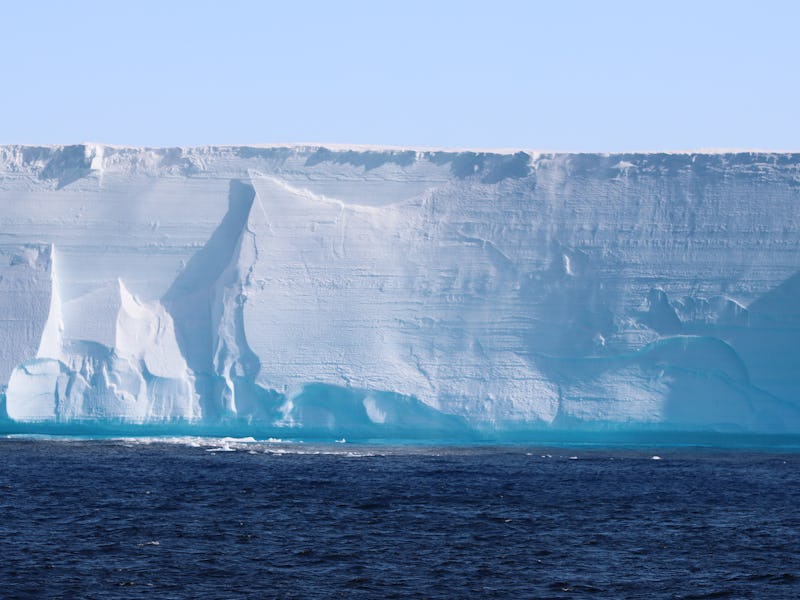An Underwater Drone Helped Scientists Explore the Final Glacial Frontier
Peeking beneath ice shelves is key for predicting sea level rise.

There are few places on Earth more remote and mysterious than the underside of Antarctica’s ice shelves. These floating tongues of ice that extend off the continent’s vast, land-bound glaciers are at the front line of polar melt and sea level rise. But we know relatively little about them — how they’re melting, changing, and moving — beyond the surface level, because it’s hard to get a good look.
Ice shelves are often hundreds of meters thick. Through satellite data and radar measurements of the surface, glaciologists can make inferences and estimates about shifts in sea ice behavior unfolding under climate change. Yet a new perspective can offer a whole lot more information, as demonstrated in a study published July 31 in the journal Science Advances. A team of scientists deployed an autonomous underwater vehicle (AUV) to explore beneath Dotson ice shelf, on the western side of Antarctica.
The unmanned submarine traveled more than 600 miles over 27 days, collecting ocean temperature, salinity, and current data while also scanning the bottom of the ice shelf using sonar for the first time. The resulting, detailed measurements allowed the researchers to construct the most detailed maps of the Dotson ever, revealing exactly how the shelf is changing and even new types of ice-shelf formations never seen before.
“It's a bit like seeing the back of the moon,” said Anna Wåhlin, lead study author and a professor of oceanography at the University of Gothenburg in Sweden, in a press statement.
The Dotson shelf is an outflow of the West Antarctic Ice Sheet, the continent’s largest contributor to sea level rise (and second only worldwide to the Greenland Ice Sheet, when it comes to melt volume). Though ice shelves don’t directly contribute to sea level rise, as they’re already floating, ice shelf losses contribute to ice loss on land, as glacial flow moves outward and the shelves and sheets fail to recover under ever-warmer conditions. Shrinking marine ice shelves can destabilize sheets on land.
As climate change progresses, Antarctica is set to become an even larger factor in globally rising tides. Understanding ice sheets is key to improving our predictions of how that melt is likely to unfold, and its subsequent impacts. And the new work offers a deeper understanding of Dotson than scientists have ever had before. The observations could help inform not only how glaciologists assess this one ice shelf but every Antarctic ice shelf.
The unmanned submarine traveled more than 600 miles over 27 days, collecting ocean temperature, salinity, and current data while also scanning the bottom of the ice shelf using sonar for the first time.
Past estimates of ice loss have failed to meet reality. This new information, combined with a wave of other recent analyses, will hopefully make for clearer, more accurate forecasts. “These new observations will help the community of ice modelers to reduce the large uncertainties in future sea level,” said Karen Heywood, a study co-author and professor of oceanography at the University of East Anglia in England in the news release.
This is not the first study to use an unmanned submarine to make measurements beneath an ice shelf; the method has been deployed for a few years. However, these are the first sub-shelf AUV data on Dotson, and it’s one of relatively few expeditions to have occurred in a growing field. For now, every mission below an Antarctic ice shelf is notable, and brings new information. Many of the new observations confirmed estimates from surface analyses: Researchers had inferred that the western portion of Dotson is thinning faster than the eastern and central sections. Data collected on currents also bolsters previous hypotheses about why that is. Water is flowing faster beneath the western part of the shelf. Yet some of the observations were totally novel.
Per the AUV scans, the underside of the eastern and central regions of the Dotson Ice Shelf is characterized by large, flat terrace-like topography, bordered by steep walls. The researchers note this melt pattern is likely the result of periodic intrusions of sea water below the ice shelf’s grounding line. In contrast, the western side of the shelf is mostly smooth on the bottom with shallow, odd features like swirling, teardrop-shaped imprints.
“There were cracks and swirls in the ice that we weren’t expecting. It looked more like art,” said Heywood. Initially, the scientists had no idea what was causing these patterns, but they’ve homed in on one hypothesis related to a known ocean current phenomenon called the Ekman spiral.
Yet still, there’s much more to uncover in the massive trove of data compiled by the solo sub. These initial maps are just the tip of the proverbial iceberg. Unfortunately, to make future observations, the researchers will need a new AUV. The marine drone the expedition had been using, dubbed Ran, disappeared below the ice during another expedition, cut woefully short. The observations on Dotson are a final transmission from a lost ship.